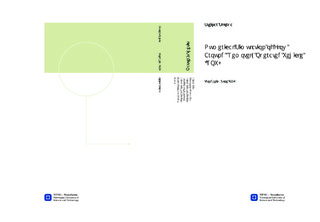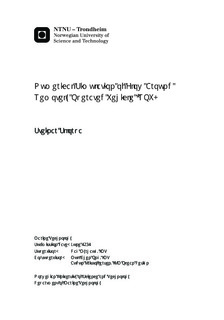| dc.description.abstract | Computational Fluid Dynamics (CFD) have been applied for numerical simulations of the flow around simplified shapes of a Remotely Operated Vehicle (ROV). The simulations have been carried out at Re = 850 000, which coincides with a free stream velocity of one knot in seawater conditions. Detached Eddy Simulation (DES) have been used with the k-w SST turbulence model in the near-wall (unsteady RANS) regions. The CFD code FLUENT from ANSYS Inc. have been used.The first case to be investigated, was a fully submerged rectangular stationary cube with both sharp and rounded edges. The sharp edged case showed good agreement with published reference values. The results for the refined mesh gave Cd = 0.8192, Clrms = 0.0473 and St = 0.1132. The Strouhal number was identical for both meshes, while small discrepancies were seen on the mean drag and the root mean square lift coefficient. For the round edged case, the mean drag coefficient was shown to be about 25% of the sharp edged case (Cd = 0.2257). The lift was more difficult to model correct and large discrepancies were seen both on the Strouhal number and the root mean square lift coefficient. It was concluded that longer time series were needed in addition to further mesh refinement in order to get more stable mean quantities of the lift history. Some effort were also made on trying the realizable k-e turbulence model in the near-wall regions for the round edged case, but without noticeably effect on the results. For both the sharp edged case and the round edged case it was concluded that although the drag was successfully modeled, a further mesh refinement was needed in order to ensure converged results.For the case of the simplified model of the ROV, three meshes were used for the grid convergence study. Small discrepancies were seen, between 2% and 6.2%. The pitch moment through the Center of Gravity (COG) was also measured and a negative mean value of Cm = -0.2563 was obtained. This means that the reported instability for the ROV was also seen in the simplified model. Through a more detailed study of the pressure and velocity distributions, the main problem regions were identified to be above the forward top and below the aft bottom. Here high-velocity regions generate low-pressure regions, which coincides with a negative pitch moment. One proposed solution was the removal of the plate in the aft which span the width of the ROV. The effect of this solution was however found to be questionable. This is due to the components which are placed in front of the plate, and these may actually cause the same effect. For this reason, these components should be relocated.It was concluded that there should be performed numerical simulations without the plate and the components in front included. The effect of these components could then be studied and a decision on whether to remove the plate could be made. Also, numerical simulations where different locations for the components in front of the plate are tried should be an interesting case to run with respect to the stability analysis. | nb_NO |

